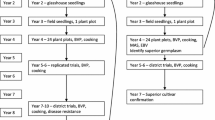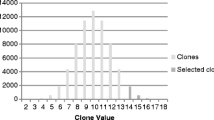Abstract
Key message
Best linear unbiased prediction (BLUP), which uses pedigree to estimate breeding values, can result in increased genetic gains for low heritability traits in autotetraploid potato.
Abstract
Conventional potato breeding strategies, based on outcrossing followed by phenotypic recurrent selection over a number of generations, can result in slow but steady improvements of traits with moderate to high heritability. However, faster gains, particularly for low heritability traits, could be made by selection on estimated breeding values (EBVs) calculated using more complete pedigree information in best linear unbiased prediction (BLUP) analysis. One complication in applying BLUP predictions of breeding value to potato breeding programs is the autotetraploid inheritance pattern of this species. Here we have used a large pedigree, dating back to 1908, to estimate heritability for nine key traits for potato breeding, modelling autotetraploid inheritance. We estimate the proportion of double reduction in potatoes from our data, and across traits, to be in the order of 10 %. Estimates of heritability ranged from 0.21 for breeder’s visual preference, 0.58 for tuber yield, to 0.83 for plant maturity. Using the accuracies of the EBVs determined by cross generational validation, we model the genetic gain that could be achieved by selection of genotypes for breeding on BLUP EBVs and demonstrate that gains can be greater than in conventional schemes.


Similar content being viewed by others
References
Anderson J, Howard H (1981) Effectiveness of selection in the early stages of potato breeding programmes. Potato Res 24:289–299
Bradshaw J (2007a) The canon of potato science: 4. Tetrasomic inheritance. Potato Res 50:219–222
Bradshaw JE (2007b) Potato-breeding strategy. In: Vreugdenhil D, Bradshaw J, Gebhardt C, Govers F, MacKerron DKL, Taylor MA, Ross HA (eds) Potato biology and biotechnology: advances and perspectives. Elsevier, Amsterdam, pp 157–177
Bradshaw JE, Mackay GR (1994) Breeding strategies for clonally propagated potatoes. In: Bradshaw JE, Mackay GR (eds) Potato genetics. Cab International, Wallingford, pp 467–497
Bradshaw JE, Dale MFB, Mackay GR (2003) Use of mid-parent values and progeny tests to increase the efficiency of potato breeding for combined processing quality and disease and pest resistance. Theor Appl Genet 107:36–42
Bradshaw JE, Bryan GJ, Hackett CA, McLean K, Pande B, Stewart HE, Waugh R (2004) Dissection and analysis of quantitative disease resistance in tetraploid potato. Euphytica 137:13–18
Bradshaw JE, Dale MFB, Mackay GR (2009) Improving the yield, processing quality and disease and pest resistance of potatoes by genotypic recurrent selection. Euphytica 170:215–227
Brown J, Caligari PDS, Mackay GR, Swan GEL (1984) The efficiency of seedling selection by visual preference in a potato breeding programme. J Agric Sci 103:339–346
Brown J, Caligari PDS, Mackay GR, Swan GEL (1987) The efficiency of visual selection in early generations of a potato breeding programme. Ann Appl Biol 110:357–363
Brown J, Caligari PDS, Dale MFB, Swan GEL, Mackay GR (1988) The use of cross prediction methods in a practical potato breeding programme. Theor Appl Genet 76:33–38
Bulmer MG (1980) The mathematical theory of quantitative genetics. Oxford University Press, Oxford
Casler MD, Brummer EC (2008) Theoretical expected genetic gains for among-and-within-family selection methods in perennial forage crops. Crop Sci 48:890–902
Diniz MCDR, Pinto CABP, Lambert ES (2006) Sample size for family evaluation in potato breeding programs. Ciênc Agrotec 30:277–282
Falconer DS, Mackay TFC (1996) Introduction to quantitative genetics, 4th edn. Pearson, Prentice Hall, Harlow
Haynes K, Gergela D, Hutchinson C, Yencho G, Clough M, Henninger M, Halseth D, Sandsted E, Porter G, Ocaya P (2012) Early generation selection at multiple locations may identify potato parents that produce more widely adapted progeny. Euphytica 186:573–583
Henderson CR (1984) Applications of linear models in animal breeding. University of Guelph, Guelph
Hill WG (2010) Understanding and using quantitative genetic variation. Philos Trans R Soc B 365:73–85
Jansky S (2009) Breeding, genetics and cultivar development. In: Singh J, Kaur L (eds) Advances in potato chemistry and technology. Academic Press, New York, pp 27–62
Kerr R, Li L, Tier B, Dutkowski G, McRae T (2012) Use of the numerator relationship matrix in genetic analysis of autopolyploid species. Theor Appl Genet 124:1271–1282
Luo ZW, Zhang Z, Leach L, Zhang RM, Bradshaw JE, Kearsey MJ (2006) Constructing genetic linkage maps under a tetrasomic model. Genetics 172:2635–2645
Maris B (1986) The effect of seed tuber weight on characters in the first and the second clonal generation of potato populations. Euphytica 35:465–482
Maris B (1988) Correlations within and between characters between and within generations as a measure for the early generation selection in potato breeding. Euphytica 37:205–224
Melo DS, Pinto CABP, Peixouto LS, Neder DG, de Assis JC (2011) Early selection of full-sib potato families. Ciênc agrotec 35:1101–1109
Milbourne D, Bradshaw JE, Hackett CA (2008) Molecular mapping and breeding in polyploid crop plants. In: Kole C, Abbott AG (eds) Principles and practices of plant genomics. Science Publishers, Enfield, pp 355–394
Otto SP, Whitton J (2000) Polyploid incidence and evolution. Ann Rev Genet 34:401–437
Piepho H, Möhring J, Melchinger A, Büchse A (2008) BLUP for phenotypic selection in plant breeding and variety testing. Euphytica 161:209–228
Simmonds NW (1985) Two-stage selection strategy in plant breeding. Heredity 55:393–399
Soltis DE, Soltis PS, Tate JA (2003) Advances in the study of polyploidy since plant speciation. New Phytol 161:173–191
Stebbins GL Jr (1947) Types of polyploids; their classification and significance. Adv Genet 1:403–429
Tai G, Young D (1984) Early generation selection for important agronomic characteristics in a potato breeding population. Am J Potato Res 61:419–434
Thornton PK (2010) Livestock production: recent trends, future prospects. Philos Trans R Soc B 365:2853–2867
Udall JA, Wendel JF (2006) Polyploidy and crop improvement. Crop Sci 46:S3–S14
van Berloo R, Hutten R, van Eck H, Visser R (2007) An online potato pedigree database resource. Potato Res 50:45–57
Van Vleck LD, Westell RA, Schneider JC (1986) Genetic change in milk yield estimated from simultaneous genetic evaluation of bulls and cows. J Dairy Sci 69:2963–2965
Xu Y, Lu Y, Xie C, Gao S, Wan J, Prasanna B (2012) Whole-genome strategies for marker-assisted plant breeding. Mol Breed 29:833–854
Acknowledgments
The authors thank Mark Verstraten and Carol Gaudion for their input into the phenotyping trials. ATS would like to thank Finlay Dale and Gisele Lairy-Joly for initial discussions on family selection. This work was supported by funding from Horticulture Australia Limited and the Victorian Department of Environment and Primary Industries.
Conflict of interest
The authors declare that they have no conflict of interest.
Ethical standards
All experiments performed comply with the current laws of Australia.
Author information
Authors and Affiliations
Corresponding author
Additional information
Communicated by H. J. van Eck.
Electronic supplementary material
Below is the link to the electronic supplementary material.
Rights and permissions
About this article
Cite this article
Slater, A.T., Wilson, G.M., Cogan, N.O.I. et al. Improving the analysis of low heritability complex traits for enhanced genetic gain in potato. Theor Appl Genet 127, 809–820 (2014). https://doi.org/10.1007/s00122-013-2258-7
Received:
Accepted:
Published:
Issue Date:
DOI: https://doi.org/10.1007/s00122-013-2258-7




